visomat Medic User manual

Gebrauchsanleitung
Instructions for use
Mode d’emploi
Istruzioni per l’uso
www.visomat.de • Besser Messen.
(DE-2 - DE-19)
(EN-20 - EN-37)
(FR-38 - FR-55)
(IT-56 - IT-72)
medicmedic
K
L
I
N
I
S
C
H
V
A
L
I
D
I
E
R
T
C
L
I
N
I
C
A
L
L
Y
V
A
L
I
D
A
T
E
D

deutsch
DE-2
DE-3
deutsch
Durch das Aufpumpen der Manschette mittels Pumpball wird der Blutfluss in der
Oberarmarterie abgestellt.Während des Entlüftungsvorgangs werden mit Beginn
des Blutflusses in der Arterie pochende Geräusche mittels Stethoskop hörbar. Bei
Beginn der Geräusche wird die Systole festgestellt, mit dem letzten hörbaren Ton
wird die Diastole erkannt. Nach Feststellung beider Werte kann die Manschette
komplett entlüftet werden.
Inhaltsverzeichnis
Wichtige Hinweise
A
Einführung
Vielen Dank, dass Sie sich für das Oberarmblutdruckmessgerät
visomat®medic (nachfolgend auch als Gerät bezeichnet) entschieden haben.
Dieses Produkt ist vorgesehen zur auskultatorischen Bestimmung des Blutdrucks.
Funktionsweise:
Diese Anleitung soll dem Benutzer helfen, das Blutdruckmessen mit Stethoskop
sicher und effizient anzuwenden. Sie muss mit dem Produkt aufbewahrt und ggf.
weitergegeben werden.
Das Gerät muss entsprechend den in dieser Anleitung enthaltenen Verfahren
verwendet werden und darf nicht für andere Zwecke eingesetzt/benutzt werden.
Lesen Sie diese Anleitung sorgfältig durch, bevor Sie das Gerät verwenden.
Pflege des Gerätes
Garantie
C
Der systolische und diastolische Blutdruckwert
Warum regelmäßig Blutdruck messen?
EAllgemeine Bestimmungen
Zeichenerklärung
1.
2.
3.
4.
5.
6.
Technische Informationen
D
Messfehler und ihre Ursachen
Kundendienst
Technische Daten
Angewandte Normen
Messtechnische Kontrolle
1.
Was sind normale Blutdruckwerte?
Was Sie über Blutdruck wissen sollten
Warum Sie unterschiedliche Werte messen
1.
2.
3.
4.
G
F
Dieses Gerät wird Patienten mit labilem Blutdruck oder bekannter Hypertonie zur
häuslichen Blutdruckkontrolle und Therapieunterstützung empfohlen.
1.
2.
3.
4.
5.
6.
B
Anlegen des Stethoskops
Blutdruck messen
Bedienung des Gerätes
Gerätebeschreibung
Anlegen der Manschette
Wichtige Anwendungshinweise
Manschette aufpumpen
4
5
5
6
7
8
8
9
10
10
10
10
10
11
11
12
12
14
14
15
16
16
17
18
Original-Ersatzteile und Zubehör

deutsch
A
DE-4
Wichtige Hinweise
DE-5
deutsch
B
Bedienung des Gerätes
Das Gerät ist auf die auskultatorische Messung des systolischen und diasto-
lischen Blutdrucks am Oberarm ausgerichtet.
•
Die mitgelieferte Standardmanschette ist auf einen Oberarmumfang von
22–32 cm ausgelegt. Für größere und kleinere Armumfänge stehen spezielle
Manschetten zur Verfügung, (Seite DE-14 Zubehör).
•
Selbstmessung bedeutet noch keine Therapie. Verändern Sie auf keinen Fall
von sich aus die vom Arzt verschriebene Dosierung der Arzneimittel.
•
Auf keinen Fall darf die Manschette auf oder über einer kritischen Stelle, z.B.
Wunde, Aneurysma etc. angelegt werden, Verletzungsgefahr! Eine Versorgung
durch einen intravaskularen Zugang (Infusion) könnte unter Umständen
unterbrochen werden.
•
Beachten Sie vor Ihren Selbstmessungen das Kapitel „Wichtige Anwendungs-
hinweise“ Seite DE-6.
•
Das Gerät darf nur mit Originalersatzteilen betrieben werden. Bei Schäden
durch fremdes Zubehör erlischt die Garantie!
•
Die Manschette darf nur am Arm aufgepumpt werden.•
Bitte halten Sie die vorgesehenen Umgebungsbedingungen zur Messung ein.
Siehe Technische Daten Seite DE-12.
•
Blutdruckmessungen an Kindern und Schwangeren bedürfen besonderer
Kenntnisse! Konsultieren Sie Ihren Arzt, wenn Sie den Blutdruck eines Kindes
oder einer Schwangeren messen möchten.
•
7
4
5
6
3
2
Gerätebeschreibung1.
Pumpball
Luftablassschalter
Manometer mit Anzeigeskala
Ohroliven
1
Stethoskopmembran
Luftanschluss
Ohrbügel
11
10
9
8
Arterienmarkierung
Manschette
Markierung für Armumfang
Kontrollmesspfeil für den Armumfang
Arterienmarkierung
Das Gerät verfügt über keine Druckbegrenzung bei 150 mmHg und sollte
deshalb nicht bei Säuglingen angewendet werden!
•
Blutdruck ist keine feste Größe. Dieser kann sich bei Patienten innerhalb
weniger Minuten um mehr als 20 mmHg nach oben oder unten verändern.
•
3
1
6
5
2
4
7
9
8
10
Stethoskopmembran
12
12
11
Luftschlauch

deutsch
B
DE-6
Bedienung des Gerätes
DE-7
deutsch
B
Bedienung des Gerätes
Vor der Messung mindestens 5 Minuten Ruhepause. Je nach Schwere der voran
gegangenen Anstrengung kann dies sogar bis zu einer Stunde erfordern.
•
Alkohol-, Nikotin- oder Koffeingenuss mindestens eine Stunde vor dem
Messen einstellen.
•
Oberarm frei machen, auf keinen Fall darf die Kleidung den Blutfluss in
oder aus dem Arm behindern, da dies den Blutdruck an der Messstelle
beeinträchtigt.
•
Wichtige Anwendungshinweise2.
Setzen Sie sich dazu ganz an den Tisch (möglichste Höhe eines Esstisches,
kein Couchtisch!) heran.
–
Die Körperhaltung muss entspannt sein:•
Lehnen Sie Ihren Rücken an der Stuhllehne an.–
Legen Sie Ihren kompletten Unterarm auf, Handinnenfläche nach oben.–
Füße auf den Boden aufstellen, Beine nicht überkreuzen.–
Anlegen der Manschette3.
Oberarm freimachen.•
Schieben Sie die Manschette über den Arm, bis
die Unterkante der Manschette 2-3 cm oberhalb
der Armbeuge liegt (Bild 1).
•
Bei Anwendung am linken Arm läuft der Luft-
schlauch in der Mitte der Armbeuge zum Gerät,
damit ist die 4 cm lange Arterienmarkierung
mittig über der Pulsstelle platziert (Bild 2).
•
Bei Anwendung am rechten Arm, muss die Man-
schette so weit nach links verdreht werden, bis
die Arterienmarkierung auf der Pulsstelle liegt.
Der Luftschlauch verläuft dann an der Innenseite
des Oberarms.
•
Die Manschette soll so fest anliegen, dass noch
2 Finger zwischen Arm und Manschette passen.
Tipp:
•
winkeln Sie den Arm leicht an–
der Oberarmmuskel wird leicht angespannt–
dadurch nimmt der Umfang des Armes leicht zu–
Prüfen Sie, ob der Pfeil auf der Manschette inner-
halb der weißen Markierung für den Armumfang
liegt.
•
Ziehen Sie jetzt das freie Manschettenende straff
und schlagen es fest über den Klettverschluss.
•
Bild 1
Bild 2: Pulsstelle
Blutdruck ist keine feste Größe. Dieser kann sich bei Patienten innerhalb
weniger Minuten um mehr als 20 mmHg nach oben oder unten verändern.
•
Die Manschettengröße ist passend zum Oberarm auszuwählen. Zu kleine
Manschetten führen zur überhöhten Anzeige der Blutdruckwerte. Armumfang
messen, Vergleich mit Angabe auf der Manschette!
•

deutsch
B
DE-8
Bedienung des Gerätes
DE-9
deutsch
B
Bedienung des Gerätes
Legen Sie den Ohrbügel des Stethoskops so an,
dass die Ohroliven fest in den Ohren sitzen. Für
den einwandfreien Sitz des Stethoskops lassen
sich die Rohre des Ohrbügels drehen. Drehen Sie
am besten die Ohroliven leicht nach vorn.
•
Mittels Pumpball die Manschette aufpumpen,
bis der Zeiger auf der Skala einen Wert anzeigt,
der etwa 30 mmHg oberhalb des zu erwartenden
systolischen Blutdruckwertes liegt.
•
Pumpen Sie bei unbekannten Blutdruckwerten
bis ca. 250 mmHg auf. Sollten Sie dennoch
deutlich pochende Geräusche im Stethoskop
hören, pumpen Sie weiter, bis keine Töne mehr
wahrzunehmen sind.
•
Manschette aufpumpen5.
Drücken Sie mit dem Zeigefinger leicht den
Luftablassschalter und lassen Sie dadurch lang-
sam die Luft aus der Manschette.
•
Der Zeiger des Manometers läuft langsam zurück.
Durch die Veränderung des Luftablassschalters
kann die Luftablassgeschwindigkeit variert
werden.
•
Hören Sie auf das rhythmische Klopfen in
Ihrem Stethoskop. Beim Verschwinden der Töne
bzw. beim letzten hörbaren Ton lesen Sie den
diastolischen Blutdruckwert auf der Skala ab und
merken sich diesen ebenfalls (Bild 2).
•
Drücken Sie nach dem Ablesen der Diastole den
Luftablassschalter ganz durch. Sie betätigen
dadurch die Schnellentlüftung, der Schalter rastet
dazu ein. Nehmen Sie die Manschette nach
kompletter Entlüftung ab.
•
Blutdruck messen6.
Führen Sie den Luftstecker der Manschette in den
Luftanschluss am Gerät ein.
•
Legen Sie den Arm mit der Manschette locker
ausgestreckt auf einen Esstisch und halten ihn
während der Messung unbedingt ruhig, sprechen
Sie nicht. Die Handinnenfläche weist nach oben.
•
Anlegen des Stethoskops4.
Beim ersten deutlich pochenden Ton lesen Sie
den systolischen Blutdruckwert auf der Skala ab
und merken sich den Wert (Bild 1).
•
(Empfehlung der WHO: 2-3 mmHg/Sekunde)
Beobachten Sie jetzt genau den Zeigerlauf auf
der Skala und achten Sie auf die Geräusche, die
Sie mit dem Stethoskop hören.
Verschließen Sie das Luftablassventil indem Sie
den Luftablassschalter nach oben drücken.
•
Bild 1
Bild 2
Other manuals for Medic
1
Table of contents
Languages:
Other visomat Blood Pressure Monitor manuals
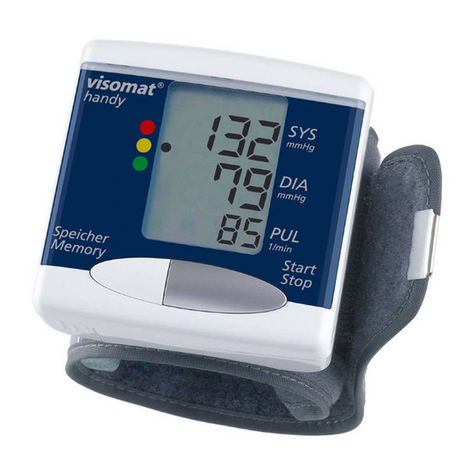
visomat
visomat handy User manual

visomat
visomat comfort eco User manual
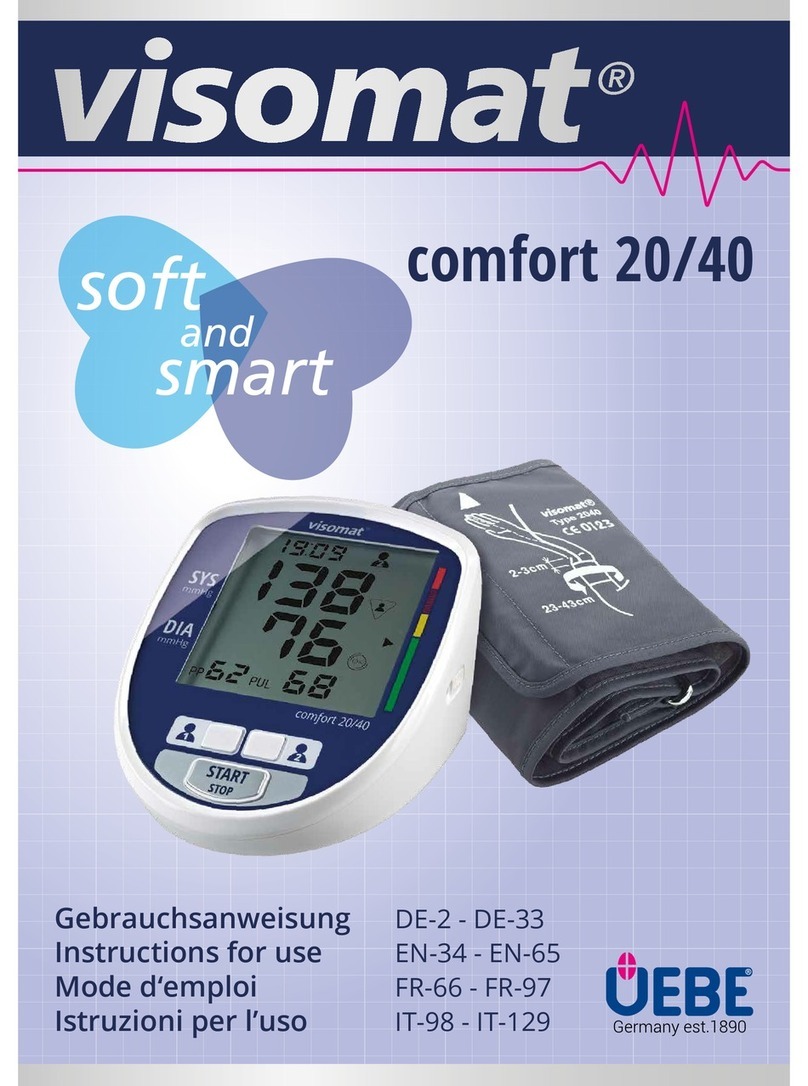
visomat
visomat comfort 20 User manual
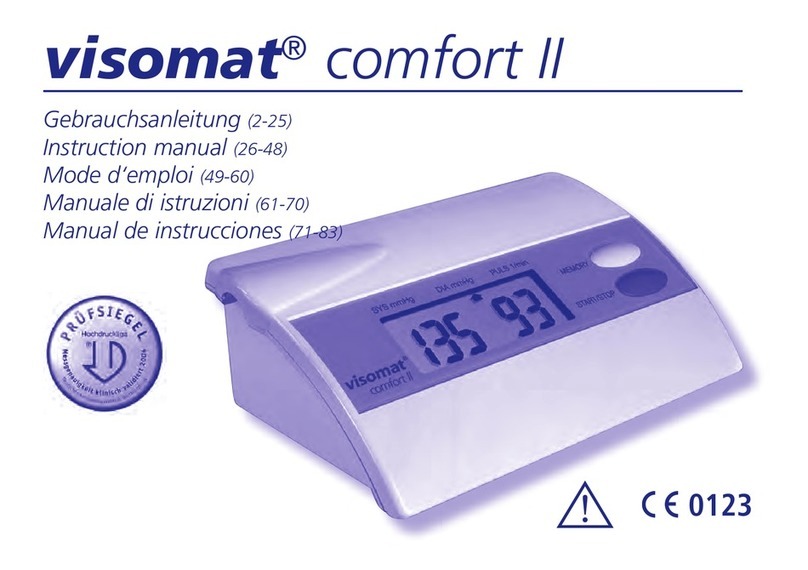
visomat
visomat comfort II User manual
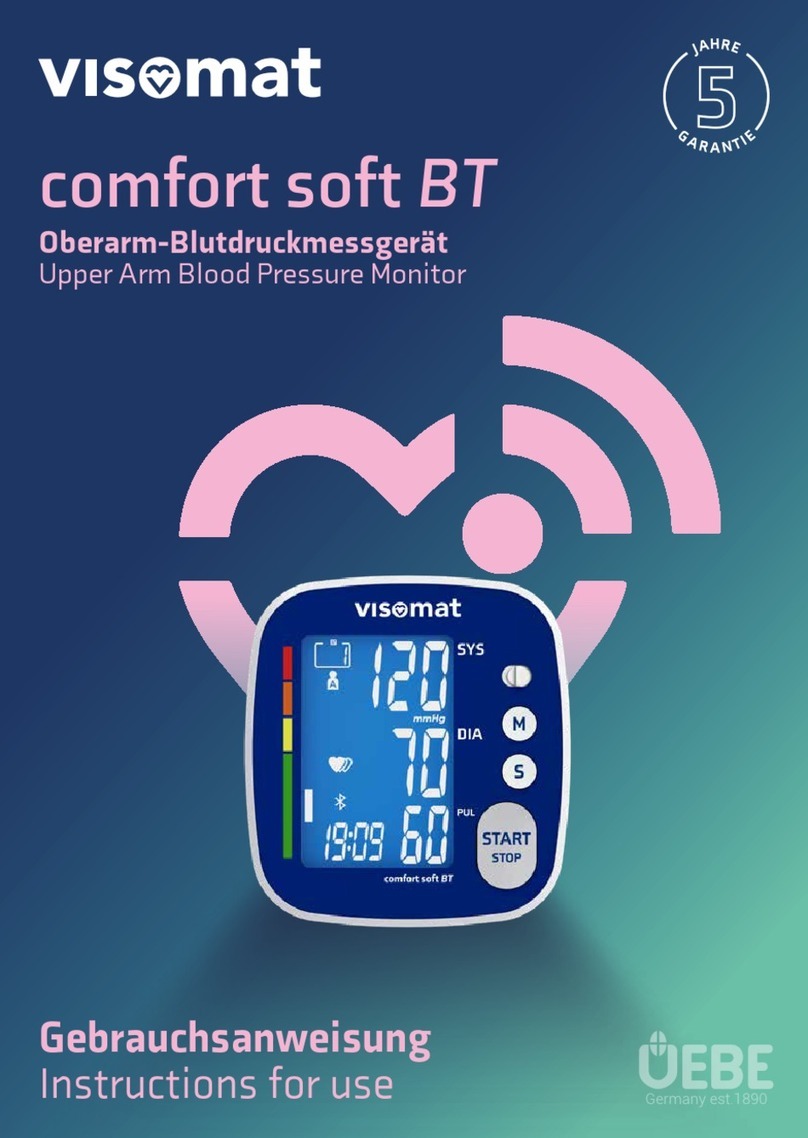
visomat
visomat comfort soft BT User manual
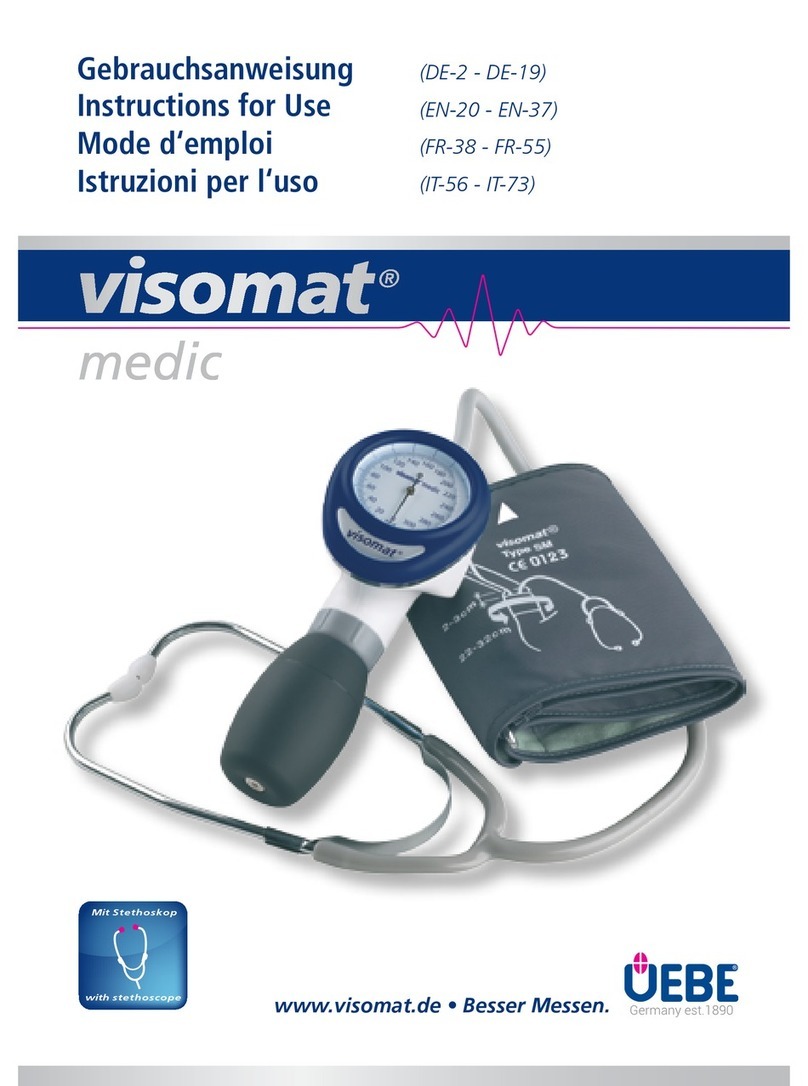
visomat
visomat Medic User manual

visomat
visomat comfort III User manual
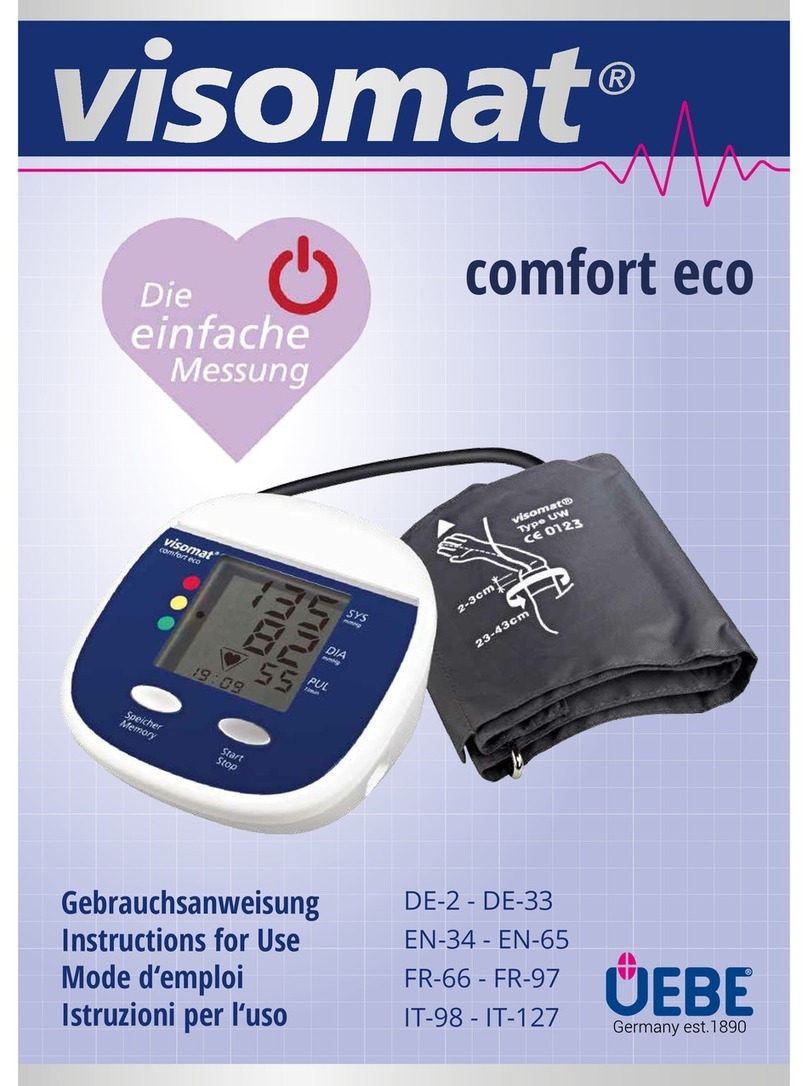
visomat
visomat comfort eco User manual
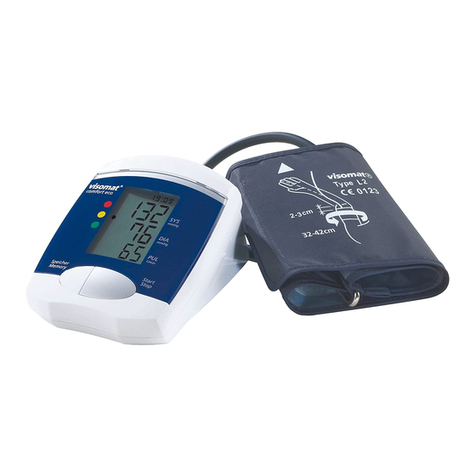
visomat
visomat comfort eco User manual
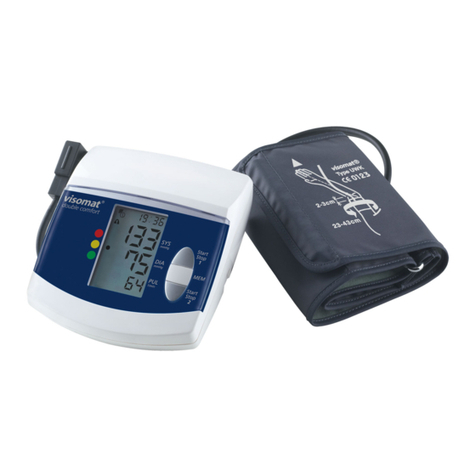
visomat
visomat double comfort User manual

















